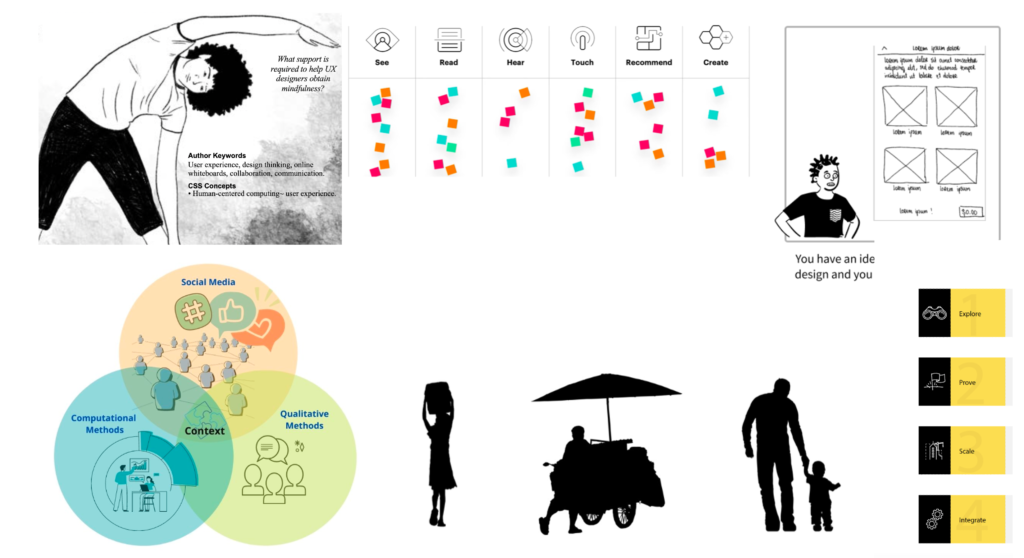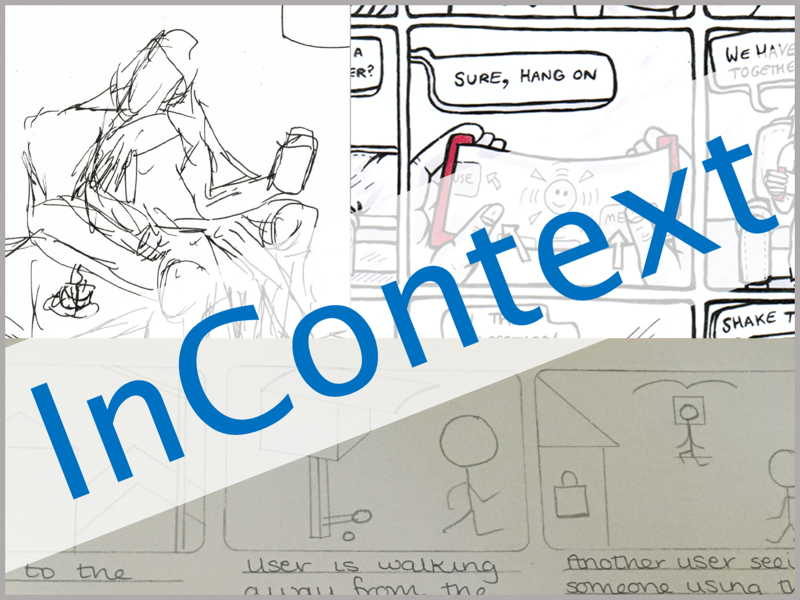Please see below that range of papers we accepted to our InContext CHI 2022 Workshop.

Morva Saaty, Jaitun V. Patel, Derek Haqq, Timothy L. Stelter, D. Scott McCrickard
(Department of Computer Science, Virginia Tech, USA)Download Full Text
Abstract: Social media captures examples of people’s behaviors, actions, beliefs, and sentiments. As a result, it can be a valuable source of information and inspiration for HCI research and design. Social media technologies can improve, inform, and strengthen insights to better understand and represent user populations. To understand the position of social media research and analysis in the design process, this paper seeks to highlight shortcomings of using traditional research methods (e.g., interviews, focus groups) that ignore or don’t adequately reflect relevant social media, and this paper speculates about the importance and benefits of leveraging social media for establishing context in supplement with these methods. We present examples that guide our thinking and introduce discussion around concerns related to using social media data.
Nur Yildirim
(HCI Institute, Carnegie Mellon University)Download Full Text
Abstract: This position paper makes the case for developing design tools, methods, and boundary objects for empowering designers to envi- sion with data and AI. I describe a study that explored how experi- enced designers work with AI, and I introduce a new design tool –a taxonomy of AI capabilities– to support practitioners in envi- sioning with AI. I discuss the details of the knowledge these tools encode, and I provide discussion points to prompt future research directions.
Yuwen Lu (University of Notre Dame, USA), Chengzhi Zhang (Carnegie Mellon University, USA), Iris Zhang, (Kings Christian Collegiate, Canada),
Toby Jia-Jun Li (University of Notre Dame, USA)Download full text
Abstract: User interface (UI) and user experience (UX) design have become an inseparable part of today’s tech industry. Recently, advancements in machine learning (ML) have opened up new opportunities for innovations in UI/UX design tools. However, many prototypes in this field haven’t been adopted in practice and a gap between ML-enabled tools and designers’ day-to-day work practices exists. To learn the underlying reasons and bridge this gap, we conducted contextual interviews with 8 UX professionals to understand their practices and identify opportunities for more translational research. We found that most current ML-enabled design tools focus on graphical interface elements, while activities involving more ‘design thinking”, such as needfinding, are as crucial for designers. Many existing system prototypes were designed for overly-simplistic scenarios that fail to integrate design projects’ practical considerations. We also identified 4 areas in the UX workflow that can benefit from additional ML-enabled assistance: design inspiration search, design alternative exploration, design system customization, and design guideline violation check.
Alarith Uhde (University of Siegen Siegen, Germany), Mena Mesenhöller (Heidelberg University Heidelberg, Germany), Marc Hassenzahl (University of Siegen Siegen, Germany)Download FULL text
Studying how social contexts shape technology interactions and how we experience them is hard. One challenge is that social con- texts are very dynamic and shaped by the situated practices of everyone involved. As a result, the same human-technology in- teraction can be experienced quite differently depending on what other people around us do. As a first step to study interpersonal and interpractice dynamics, we collected a broad range of visual representations of practices, such as “riding a bike” or “skipping the rope”. This material can be used to further explore how different, co-located practices relate to each other.
Makayla Lewis (Kingston University, London)Download full text
The foundation of user experience (UX) design is the ability to communicate clearly and effectively within design teams throughout the design process. As a result, UX practitioners often use a multitude of tools to communicate understandings, explorations, prototypes, and learnings. For learners and entry-level UX practitioners this can be overwhelming, this workshop position pictorial discusses and questions the possibility of a ‘one-stop shop’ for UX design tools, Miro an online collaborative whiteboard, to bring together, harmonize, UX design tools for practitioners and learners whilst allowing them to maintain mindfulness in their current learning, thinking, and practice environments (Figure 1).
Jose Abdelnour Nocera
(University of West London and ITI/Larsys), Lene Nielsen (IT University Copenhagen, Dept. of Business IT), Christina Li (Infinite Interactive LTD)Download full text
We raise the question: do we need to assess the service design tools and their usability? We suggest including the organisational context and we also need to understand the maturity of the organisation in order to address the usability of the service design tools. The research program we propose will also shed light on how other type of design tools are affected by organisational usability and maturity models.
K. J. Kevin Feng (University of Washington, USA), Amy X. Zhang (University of Washington, USA)Download full text
UX design tools have made significant advancements in supporting real-time collaboration within design files that drastically shift the way teams discuss and iterate on designs. However, designs often still have little connection to the underlying technologies that power user interfaces when implemented, which limits how deeply designers can collaborate with technical non-designers. We propose new ways design tools can move from one-time handoffs towards supporting deeper co-creation between designers and technical stakeholders, specifically developers and data science workers, to create interactive and expressive interface designs. We do so through two main focus areas that connect code and data with design—bridging designer-developer divergence through component-based synchronization, and empowering designerly interaction with data to help prototype probabilistic interfaces. We conclude with a discussion on the implications of these two focus areas on future design tools.
Yashi Jain (Swansea University, Wales, UK), Pranjal Jain (Swansea University, Wales, UK)Download full text
The paper aims to integrate the circular economy and design pro- cess to develop sustainable artificial intelligence (AI). Designers are known for comprehending people, imparting values, attitudes, and perceived user demands and want. We laid down a basis for theory-building regarding the role of designers within the circular economy (CE). We contribute to the process of implementing CE principles in order to reduce the harm caused by the production and consumption of technology. Using CE principles, the paper develops in the direction of making technological developments that are ecologically beneficial, leading to the design of better AI. This work suggests a circular design plugin that may be used with design prototyping software to build AI.
Clara Kliman-Silver (Google Mountain View, CA, USA), Tiffany Knearem (Google Mountain View, CA, USA), Joseph Wheeler (Independent Researcher New York, NY, USA)Download text here
Recently, artificial intelligence (AI) has been introduced into a vari- ety of software platforms aimed at supporting creative endeavors. While AI-driven features in design tooling are nascent, we view AI as having the potential for positive impact on user experience and product designer workflows. We conducted a series of studies to investigate how designers perceive AI-driven experiences in design tooling. The findings suggest that designers view AI as suited to identifying and correcting errors and as agents for inspiring cre- ativity. However, trust and explainability are key to acceptance. Our goal is to inform the future of design tooling through further development of these initial inclinations.
Sarah Rüller, Konstantin Aal, Anne Weibert (Collaborative Research Centre 1187
Media of Cooperation
University of Siegen
Siegen, Germany)Download full text
Literacy is mostly understood as the ability to read and write, completely leaving out knowledge and expertise gained through shared stories, oral transmission, and lived experiences without written documentation. Bridging this perspective to UX design allows for the question: “How do we address technological inquiries and UX-related questions in and for contexts, that are not digitally native, but orally-literate?” Our position paper presents three cases of creative and non-technical approaches to technological issues, rooted in contexts and communities with various cultures and languages and different degrees of literacy involved. Through theatre activities, storytelling, and games, we mutually explore the potential of these entrances to technological questions and, in a second step, the implications for the future of UX design and research.
Maria Murray (School of Applied Psychology University College Cork Cork, Ireland)Download full text
User experience (UX) design is concerned with working with people to develop products and processes in response to their specific needs, expectations and contexts. This gives rise to the question of participation in design, a concept that designers and design educators themselves are not necessarily always familiar with. It also engages with social justice, as these various needs, expectations and contexts are typically both personal and political. Socially Engaged Art (SEA) has long been preoccupied with questions of participation, specifically transformative participation that turns “spectators” into “actors”, promoting more active and agentic citizens. As user experience design engages with social justice issues and looks towards contributing to more sustainable and equitable futures, it could benefit from integrating SEA theory and practice into both configuring meaningful and equitable participation, and creating design processes that marry design principles and practices with arts- based modes of creative exploration and expression.
